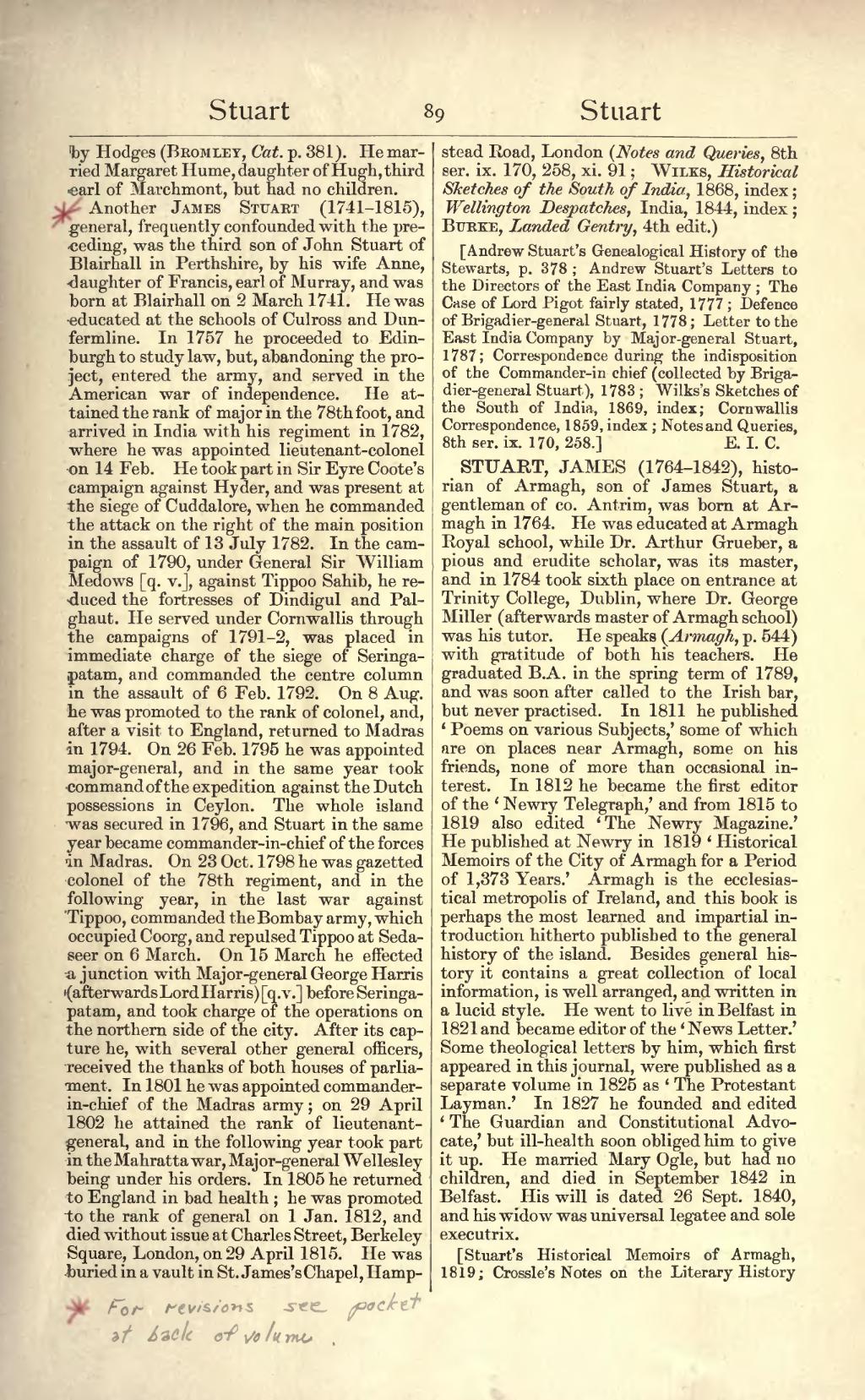by Hodges (Bromley, Cat. p. 381). He married Margaret Hume, daughter of Hugh, third earl of Marchmont, but had no children.
Another James Stuart (1741–1815), general, frequently confounded with the preceding, was the third son of John Stuart of Blairhall in Perthshire, by his wife Anne, daughter of Francis, earl of Murray, and was born at Blairhall on 2 March 1741. He was educated at the schools of Culross and Dunfermline. In 1757 he proceeded to Edinburgh to study law, but, abandoning the project, entered the army, and served in the American war of independence. He attained the rank of major in the 78th foot, and arrived in India with his regiment in 1782, where he was appointed lieutenant-colonel on 14 Feb. He took part in Sir Eyre Coote's campaign against Hyder, and was present at the siege of Cuddalore, when he commanded the attack on the right of the main position in the assault of 13 July 1782. In the campaign of 1790, under General Sir William Medows [q. v.], against Tippoo Sahib, he reduced the fortresses of Dindigul and Palghaut. He served under Cornwallis through the campaigns of 1791–2, was placed in immediate charge of the siege of Seringapatam, and commanded the centre column in the assault of 6 Feb. 1792. On 8 Aug. he was promoted to the rank of colonel, and, after a visit to England, returned to Madras in 1794. On 26 Feb. 1795 he was appointed major-general, and in the same year took command of the expedition against the Dutch possessions in Ceylon. The whole island was secured in 1796, and Stuart in the same year became commander-in-chief of the forces in Madras. On 23 Oct. 1798 he was gazetted colonel of the 78th regiment, and in the following year, in the last war against Tippoo, commanded the Bombay army, which occupied Coorg, and repulsed Tippoo at Sedaseer on 6 March. On 15 March he effected a junction with Major-general George Harris (afterwards Lord Harris) [q. v.] before Seringapatam, and took charge of the operations on the northern side of the city. After its capture he, with several other general officers, received the thanks of both houses of parliament. In 1801 he was appointed commander-in-chief of the Madras army; on 29 April 1802 he attained the rank of lieutenant-general, and in the following year took part in the Mahratta war, Major-general Wellesley being under his orders. In 1805 he returned to England in bad health; he was promoted to the rank of general on 1 Jan. 1812, and died without issue at Charles Street, Berkeley Square, London, or 29 April 1815. He was buried in a vault in St. James's Chapel, Hampstead Road, London (Notes and Queries, 8th ser. ix. 170, 258, xi. 91; Wilks, Historical Sketches of the South of India, 1869, index; Wellington Despatches, India, 1844, index; Burke, Landed Gentry, 4th edit.).
[Andrew Stuart's Genealogical History of the Stewarts, p. 378; Andrew Stuart's Letters to the Directors of the East India Company; The Case of Lord Pigot fairly stated, 1777; Defence of Brigadier-general Stuart, 1778; Letter to the East India Company by Major-general Stuart, 1787; Correspondence during the indisposition of the Commander-in-chief (collected by Brigadier-general Stuart), 1783; Wilks's Sketches of the South of India, 1869, index; Cornwallis Correspondence, 1859, index; Notes and Queries, 8th ser. ix. 170, 258.]
STUART, JAMES (1764–1842), historian of Armagh, son of James Stuart, a gentleman of co. Antrim, was born at Armagh in 1764. He was educated at Armagh Royal school, while Dr. Arthur Grueber, a pious and erudite scholar, was its master, and in 1784 took sixth place on entrance at Trinity College, Dublin, where Dr. George Miller (afterwards master of Armagh school) was his tutor. He speaks (Armagh, p. 544) with gratitude of both his teachers. He graduated B.A. in the spring term of 1789, and was soon after called to the Irish bar, but never practised. In 1811 he published ‘Poems on various Subjects,’ some of which are on places near Armagh, some on his friends, none of more than occasional interest. In 1812 he became the first editor of the ‘Newry Telegraph,’ and from 1815 to 1819 also edited ‘The Newry Magazine.’ He published at Newry in 1819 ‘Historical Memoirs of the City of Armagh for a Period of 1,373 Years.’ Armagh is the ecclesiastical metropolis of Ireland, and this book is perhaps the most learned and impartial introduction hitherto published to the general history of the island. Besides general history it contains a great collection of local information, is well arranged, and written in a lucid style. He went to live in Belfast in 1821 and became editor of the ‘News Letter.’ Some theological letters by him, which first appeared in this journal, were published as a separate volume in 1825 as ‘The Protestant Layman.’ In 1827 he founded and edited ‘The Guardian and Constitutional Advocate,’ but ill-health soon obliged him to give it up. He married Mary Ogle, but had no children, and died in September 1842 in Belfast. His will is dated 26 Sept. 1840, and his widow was universal legatee and sole executrix.
[Stuart's Historical Memoirs of Armagh, 1819; Crossle's Notes on the Literary History
